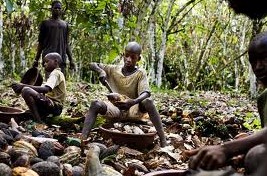想到巧克力,不禁口水直流。到底是从什么时候起,世界上就有了这种美味的食物呢?从“给猪喝的苦涩饮料”到风靡欧洲的时髦饮品,从贵族特权到全民之爱,巧克力辗转完成变身,在人类千年的宠爱中向着更加精致美味的方向继续前行……
When most of us hear the word chocolate, we picture a bar, a box of bonbons1), or a bunny2). The verb that comes to mind is probably "eat", not "drink", and the most apt3) adjective would seem to be "sweet". But for about 90 percent of chocolate's long history, it was strictly a beverage, and sugar didn't have anything to do with it.  大多数人听到巧克力这个词时,就会联想到一条巧克力棒、一盒奶油夹心巧克力糖,或一只巧克力兔子。进入脑海的动词则很可能是“吃”,而并非“喝”;而我们想到的最恰当的形容词大概是“甜”。然而严格说来,在巧克力发展的漫长历史中,人们在绝大部分时间里都把它当做一种饮料,而且糖跟它一点关系也没有。
大多数人听到巧克力这个词时,就会联想到一条巧克力棒、一盒奶油夹心巧克力糖,或一只巧克力兔子。进入脑海的动词则很可能是“吃”,而并非“喝”;而我们想到的最恰当的形容词大概是“甜”。然而严格说来,在巧克力发展的漫长历史中,人们在绝大部分时间里都把它当做一种饮料,而且糖跟它一点关系也没有。
"I often call chocolate the best-known food that nobody knows anything about," said Alexandra Leaf, a self-described "chocolate educator" who runs a business called Chocolate Tours of New York City.
“我常说,巧克力是人人都知道但却对它一无所知的食品。”亚历山德拉·利夫如是说。她自诩为“巧克力教师”,还经营着一家名为“纽约巧克力之旅”的商店。
The Origin of Chocolate
巧克力的起源
 The terminology can be a little confusing, but most experts these days use the term "cacao" to refer to the plant or its beans before processing4), while the term "chocolate" refers to anything made from the beans. "Cocoa" generally refers to chocolate in a powdered form, although it can also be a British form of "cacao".
The terminology can be a little confusing, but most experts these days use the term "cacao" to refer to the plant or its beans before processing4), while the term "chocolate" refers to anything made from the beans. "Cocoa" generally refers to chocolate in a powdered form, although it can also be a British form of "cacao".
虽然有点儿让人无法理解,可如今的大多数专家都用“可可”这一术语指代可可树或尚未加工的可可豆,而用“巧克力”这一术语指代任何经由可可豆加工而成的食品。一般而言,“可可粉”是指粉末状的巧克力,虽然它在英国人眼里也是“可可”的一种形式。
Etymologists5) trace the origin of the word "chocolate" to the Aztec6) word "xocoatl", which referred to a bitter drink brewed from cacao beans. The Latin name for the cacao tree, Theobroma cacao, means "food of the gods".
词源学家对“巧克力”一词追根溯源,认为它来自阿兹特克语中“xocoatl”一词,该词指的是一种由可可豆酿制而成的苦涩饮料。在拉丁语中,可可树被称作“Theobroma cacao”,意为“神灵的食物”。
Many modern historians have estimated that chocolate has been around for about 2000 years, but recent research suggests that it may be even older.
据许多现代历史学家估算,巧克力已有大约两千年的历史,但最新研究表明,它的历史可能还要更久。
In the book The True History of Chocolate, authors Sophie and Michael Coe make a case7) that the earliest linguistic evidence of chocolate consumption stretches back three or even four millennia8), to pre-Columbian cultures of Mesoamerica9) such as the Olmec10).
在《巧克力的真实历史》一书中,作者索菲和迈克尔·科以充分的证据证实,关于食用巧克力的最早文字记录可追溯至三千甚至四千年前,那是哥伦布发现新大陆之前的中美洲文明——如奥尔梅克文明——所在的年代。
Last November, anthropologists from the University of Pennsylvania announced the discovery of cacao residue11) on pottery excavated in Honduras12) that could date back as far as 1400 B.C.E. It appears that the sweet pulp13) of the cacao fruit, which surrounds the beans, was fermented14) into an alcoholic beverage of the time.
去年11月,宾夕法尼亚大学的人类学家宣布在从洪都拉斯出土的瓷器上发现了可可豆残渣的遗迹,其年代之久远可追溯至公元前1400年。看来,当时人们好像把包裹可可豆的甜美果肉发酵酿制成了一种含酒精的饮料。
"Who would have thought, looking at this, that you can eat it?" said Richard Hetzler, executive chef of the café at the Smithsonian's National Museum of the American Indian, as he displayed a fresh cacao pod15) during a recent chocolate-making demonstration. "You would have to be pretty hungry, and pretty creative!"
“看看这个,谁会认为这可以吃呢?”美国史密苏尼国家博物馆印第安人馆咖啡厅的行政总厨理查德·赫茨勒在最近的一次巧克力制作演示中展示一个新鲜的可可豆荚时这样说道,“要是你能想到,那你当时肯定饥肠辘辘,同时还得有丰富的创造力。”
Valuable and Fashionable Chocolate Beverage
珍贵时髦的巧克力饮料
It's hard to pin down16) exactly when chocolate was born, but it's clear that it was cherished from the start. For several centuries in pre-modern Latin America, cacao beans were considered valuable enough to use as currency. One bean could be traded for a tamale17), while 100 beans could purchase a good turkey hen, according to a 16th-century Aztec document.
我们很难确定巧克力诞生的确切年代,但有一点是很明确的,那就是自诞生之初,巧克力就一直备受珍爱。在前现代的拉丁美洲,人们在几个世纪里一直把可可豆视若珍宝,甚至把它当做货币使用。根据一份16世纪的阿兹特克文件记载,用一颗可可豆可以换来一个墨西哥玉米粉蒸肉卷,而用一百颗可可豆可以买到一只上好的母火鸡。
Both the Mayans and Aztecs believed the cacao bean had magical, or even divine, properties18), suitable for use in the most sacred19) rituals of birth, marriage and death. According to Chloe Doutre-Roussel's book The Chocolate Connoisseur20), Aztec sacrifice victims who felt too melancholy21) to join in ritual dancing before their death were often given a gourd of chocolate (tinged with the blood of previous victims) to cheer them up.
玛雅人和阿兹特克人都认为可可豆具有神秘的甚至是神圣的特性,适合在诸如出生、结婚和死亡这些最神圣的仪式上使用。根据克洛艾·杜特-鲁塞尔的《巧克力鉴赏家》一书所述,阿兹特克的被献祭者因极度抑郁而无法参加祭祀之舞时,人们就在他们被献祭之前给他们喝下一瓢巧克力(含有少许已故祭祀品的血),使他们振奋起来。
Sweetened chocolate didn't appear until Europeans discovered the Americas and sampled the native cuisine. Legend has it that the Aztec king Montezuma22) welcomed the Spanish explorer Hernando Cortés with a banquet that included drinking chocolate, having tragically mistaken him for a reincarnated23) deity instead of a conquering invader. Chocolate didn't suit the foreigners' taste buds24) at first—one described it in his writings as "a bitter drink for pigs"—but once mixed with honey or cane sugar, it quickly became popular throughout Spain.
后来,欧洲人发现了美洲大陆,并品尝了当地的菜肴,至此加糖的巧克力才出现。据传说,阿兹特克国王蒙提祖马准备了一桌以巧克力为饮料的盛宴,为西班牙探险者埃尔南多·科尔特斯接风洗尘——国王不但没有把他当做前来征战的入侵者,反而可悲地误以为他是转世神灵。起初,外国人并不能接受巧克力的味道——有人在著作中把巧克力描述为“一种给猪喝的苦涩饮品”——不过,在添加了蜂蜜或蔗糖以后,巧克力饮料立刻红遍西班牙各地。
By the 17th century, chocolate was a fashionable drink throughout Europe, believed to have nutritious, medicinal and even aphrodisiac25) properties.But it remained largely a privilege of the rich until the invention of the steam engine made mass production possible in the late 1700s.
到17世纪时,巧克力成了风靡整个欧洲的时髦饮品。人们认为它有营养,能入药,甚至还能催情。但它仍旧是有钱人才能享用的奢侈品,直到18世纪末蒸汽机的发明使得大规模生产成为可能以后,这种情况才得以改善。
The Birth of Solid Chocolate
固态巧克力的诞生
 In 1828, a Dutch chemist found a way to make powdered chocolate by removing about half the natural fat (cacao butter) from chocolate liquor, pulverizing26) what remained and treating the mixture with alkaline27) salts to cut the bitter taste. His product became known as "Dutch cocoa", and it soon led to the creation of solid chocolate.
In 1828, a Dutch chemist found a way to make powdered chocolate by removing about half the natural fat (cacao butter) from chocolate liquor, pulverizing26) what remained and treating the mixture with alkaline27) salts to cut the bitter taste. His product became known as "Dutch cocoa", and it soon led to the creation of solid chocolate.
1828年,一位荷兰化学家找到了制作巧克力粉的方法:他从巧克力饮料中去除了近一半的天然脂肪(即可可脂),然后把剩下的成分研磨成粉,并在其中添加碱盐以减轻苦涩味道。他的产品被称为“荷兰可可粉”,由此很快诞生了固态巧克力。
The creation of the first modern chocolate bar is credited to Joseph Fry, who in 1847 discovered that he could make a moldable chocolate paste by adding melted cacao butter back into Dutch cocoa.
第一条现代巧克力棒的产生应归功于约瑟夫·弗赖伊。1847年,弗赖伊发现,通过往荷兰可可粉中重新添加融化的可可脂,能够做出可塑形的糊状巧克力。
By 1868, a little company called Cadbury was marketing boxes of chocolate candies in England. Milk chocolate hit the market a few years later, pioneered28) by another name that may ring a bell29)—Nestle.
到了1868年,一家名为“吉百利”的小公司开始在英国出售盒装巧克力糖果。几年以后,另一个令人耳熟的公司——雀巢——开发出的牛奶巧克力面市了。
Prosperous Chocolate Industry
繁荣的巧克力产业
 In America, chocolate was so valued during the Revolutionary War30) that it was included in soldiers' rations31) and used in lieu of32) wages. While most of us probably wouldn't settle for33) a chocolate paycheck these days, statistics show that the humble cacao bean is still a powerful economic force. Chocolate manufacturing is a more than 4-billion-dollar industry in the United States, and the average American eats at least half a pound of the stuff per month.
In America, chocolate was so valued during the Revolutionary War30) that it was included in soldiers' rations31) and used in lieu of32) wages. While most of us probably wouldn't settle for33) a chocolate paycheck these days, statistics show that the humble cacao bean is still a powerful economic force. Chocolate manufacturing is a more than 4-billion-dollar industry in the United States, and the average American eats at least half a pound of the stuff per month.
美国独立战争时期,巧克力极为珍贵,不仅用于士兵的军需补给,还用来代替薪水向士兵发放。现在,我们中的大多数人很可能并不会满足于拿巧克力薪水,但统计数据证明,不起眼的可可豆仍是一股强有力的经济力量。在美国,巧克力制造业的市值可达四十多亿美元,美国人平均每月至少食用0.5磅的巧克力。
In the 20th century, the word "chocolate" expanded to include a range of affordable treats with more sugar and additives34) than actual cacao in them, often made from the hardiest but least flavorful of the bean varieties.
在20世纪,“巧克力”一词的范围扩展到一系列人们买得起的巧克力糖果,这些糖果中添加的糖和添加剂比可可豆成分更多,并且选用的可可豆也是最硬而且口味最差的品种。
But more recently, there's been a "chocolate revolution," Leaf said, marked by an increasing interest in high-quality, handmade chocolates and sustainable, effective cacao farming and harvesting methods. Major corporations like Hershey's have expanded their artisanal35) chocolate lines by purchasing smaller producers known for premium36) chocolates, such as Scharffen Berger and Dagoba, while independent chocolatiers continue to flourish as well.
但是,近来掀起了一场“巧克力革命”,这场革命以不断增长的对高品质的追求、手工巧克力制作和高效且可持续的可可种植及采集方式为特点。通过收购诸如“沙尔芬贝格”和“叠哥芭”等小型优质巧克力生产企业,像“好时”巧克力这样的大型企业扩大了他们的手工生产线。而与此同时,独立的巧克力生产企业也繁荣依旧。
1. bonbon [ˈbɒnbɒn] n. 夹心巧克力糖果
2. bunny [ˈbʌni] n. 兔子,尤指小兔子。西方复活节常见的食品之一便是小兔子造型的巧克力。
3. apt [æpt] adj. 恰当的,适当的
4. process [ˈprəʊses] v. 加工
5. etymologist [ˌetɪˈmɒlədʒɪst] n. 词源学家
6. Aztec: 阿兹特克人的。阿兹特克人是印第安人的一个分支,主要分布在墨西哥中部和南部。阿兹特克文明是古代阿兹特克人所创造的印第安文明,是美洲古代三大文明之一,1521年被西班牙人征服。
7. make (out) a case (for): 证明……有理由,提出有利于……的理由
8. millennia [mɪˈleniəm] n. 一千年[millennium的复数]
9. Mesoamerica [ˌmɛsəʊəˈmɛrɪkə] n. 中美洲,其范围从墨西哥中部向南向东延伸,包括危地马拉、伯利兹、洪都拉斯及尼加拉瓜在内的地区。在哥伦布发现新大陆以前的时代,这里曾存在过各种文明,包括玛雅文明及奥尔梅克文明。
10. Olmec: 奥尔梅克人(墨西哥古印第安人)
11. residue [ˈrezɪdjuː] n. 残余,渣滓
12. Honduras [hɒnˈdjʊərəs] n. 洪都拉斯(拉丁美洲国家)
13. pulp [pʌlp] n. (水果的)果肉
14. ferment [fə(r)ˈment] vt. (使)发酵
15. pod [pɒd] n. 豆荚
16. pin down: 确定,证实
17. tamale [təˈmɑːli] n. (墨西哥的)玉米粉蒸肉卷(以玉米粉同肉末拌和,加胡椒,用玉米面包好后蒸熟)
18. property [ˈprɒpə(r)ti] n. 特性,性质
19. sacred [ˈseɪkrɪd] adj. 神圣的
20. connoisseur [ˌkɒnəˈsɜː(r)] n. (艺术品的)鉴赏家,鉴定家,内行
21. melancholy [ˈmelənkəli] adj. 忧郁的
22. Montezuma [mɒntɪˈzuːma] 蒙提祖马,这里指蒙提祖马二世(1466?〜1520),(墨西哥)阿兹特克帝国的国王,曾一度称霸中美洲,在西班牙征服墨西哥之战(Spanish Conquest of Mexico)初期被杀害。他在位期间,阿兹台克帝国的疆土达到最大,本土文明和欧洲文明首次发生碰撞。
23. reincarnated [ˌriːɪnkɑː(r)ˈneɪtɪd] adj. 转世的
24. taste bud: 味蕾
25. aphrodisiac [ˌæfrəˈdɪziæk] adj. 催情的
26. pulverize [ˈpʌlvəraɪz] vt. 研磨成粉
27. alkaline [ˈælkəˌlaɪn] adj. 【化】碱的, 碱性的
28. pioneer [ˌpaɪəˈnɪə(r)] vt. 开辟;倡导
29. ring a bell:<口> 引起模糊回忆
30. Revolutionary War: 这里指美国革命战争(1775~1783),或称美国独立战争(American War of Independence),是北美13个英属殖民地反抗英国殖民统治、争取民族独立的革命战争。
31. ration [ˈræʃ(ə)n] n. (给战士或食品短缺地区的人提供的)定量口粮
32. in lieu of: 代替
33. settle for: 勉强接受
34. additive [ˈædətɪv] n. 添加剂
35. artisanal [ˈɑː(r)tɪzənəl] adj. 手工艺的
36. premium [ˈpriːmiəm] adj. 优质的
